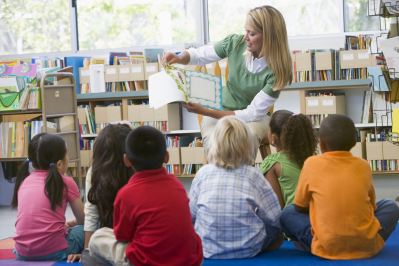Teaching for Learning: Reading
Update December 2020:
This web page is a companion to the 2016 version of the School Library Program Rubric. NYSED released an updated School Library Program Rubric in December 2020.
Student Snapshot: Students who have high levels of reading literacy become successful, independent, life-long readers.
According to the American Association of School Librarians (2007) reading is a foundational skill for learning, personal growth, and enjoyment. The degree to which students can read and understand text in all formats (e.g., picture, video, print) and all contexts is a key indicator of success in school and in life. As a lifelong learning skill, reading goes beyond decoding and comprehension to interpretation and development of new understandings.
Source: American Association of School Librarians. “Standards for the 21st-Century Learner.” American Association of School Librarians, 2007.
Citation for Photo: NCC Approved Image
In Practice
School Library Media Specialist’s Role in Reading Toolkit
Description: Reading is a foundational skill for 21st-century learners. Guiding learners to become engaged and effective users of ideas and information and to appreciate literature requires that they develop as strategic readers who can comprehend, analyze, and evaluate text in both print and digital formats. Learners must also have opportunities to read for enjoyment as well as for information. School librarians are in a critical and unique position to partner with other educators to elevate the reading development of our nation’s youth.
Resource/Citation: American Association of School Librarians. “School Library Media Specialist's Role in Reading Toolkit.” American Association of School Librarians, 2010.
Reading Comprehension: Strategies for Independent Learners
Description: Research-based approaches to comprehension instruction, designed to help
K-9 students compare and evaluate print and online sources, build study skills, and become
motivated readers.
*Resource/Citation: Blachowicz, Camille and Donna Ogle. Reading Comprehension: Strategies for Independent Learners. 2nd Ed. Guildford Publications, 2008.
Literature Circles: A School Librarian Initiative for Assisting Struggling Readers
Description: The article analyzes struggling readers' motivation via the lens of school library media specialists (SLMS) and identifies ways by which the specialists can support classroom teachers and struggling readers in developing literature circles. It examines 3 specific, non-negotiable elements of an effective literature circle and notes how SLMS can foster reading motivation among struggling readers by working with teachers in addressing struggling readers' need for engagement in literature circles.
*Resource/Citation: Herdelin, Jamey. "Literature Circles: A School Librarian Initiative for Assisting Struggling Readers." Kentucky Libraries, vol. 78, no. 1, 2014, pp. 24-28. EBSCOHost,
Just a Little Thing: Reading Must Be at the Heart of 21st Century Learning
Description: The article discusses the need for re-designing school libraries at the John Oliver (JO) Secondary School in Vancouver, British Columbia into learning commons for new learning and teaching culture. Topics discussed include development of Jo learning commons program by teacher-librarians, incorporation of digital literacy discourses into reading and learning, and a framework of inquiry model proposed by the British Columbia Teacher-Librarians Association.
*Resource/Citation: Ekdahl, Moira. "Just A Little Thing: Reading Must Be At The Heart Of 21st Century Learning." School Libraries In Canada, vol. 31, no. 2, 2013, pp. 42-50. EBSCOHost,
School Librarian’s Role in Reading Toolkit
Description: The American Association of School Librarians compiled this toolkit to guide school librarians in developing students’ reading development. Resources on collaborating, researching, reading comprehension, and digital tools provide targeted information specifically for school librarians.
Resource/Citation: American Association of School Librarians. "School Librarian's Role in Reading Toolkit." American Association of School Librarians, July 2009.
Coteaching Reading Comprehension Strategies in Elementary School Libraries: Maximizing Your Impact
Description: This book provides clear instructions for teaching reading comprehension through collaboration between educators. A teacher-librarian herself, Moreillon includes sample lesson plans, collaboration techniques, and guidance for library programs.
*Resource/Citation: Moreillon, Judy. Coteaching Reading Comprehension Strategies in Elementary School Libraries: Maximizing Your Impact. ALA Editions, 2013.
In Theory
Position Statement on the Role of the School Librarian in Reading Development
Description: The American Association of School Librarians articulates the key characteristics of a strong reading program in a school library, and affirms the importance of district-wide collaboration. Key characteristics include flexible scheduling, varied collections, and staff development.
Resoruce/Citation: American Association of School Librarians. "Position Statement on the Role of the School Librarian in Reading Development." American Association of School Librarians, 1 Sept. 2010.
Position Statement on the School Library Media Specialist’s Role in Reading
Description: Guiding learners to become engaged and effective users of ideas and information and to appreciate literature requires that they develop as strategic readers who can comprehend, analyze, and evaluate text in both print and digital formats. School librarians are in a critical and unique position to partner with other educators to elevate the reading development of our nation’s youth.
Resource/Citation: American Association of School Librarians. “Position Statement on the School Library Media Specialist’s Role in Reading”. American Association of School Librarians, 2010.
The Role of a School Library in a School’s Reading Program
Description: As a foundational element of schooling, learning to read and reading to learn is every bit as important in the 21st century as it has ever been. Whether interacting online, doing assignments, taking tests, or social networking, the ability to read and read well affects every part of one's existence and often predicts success throughout life. In this article, the authors discuss the role of a school library in a school's reading program and offer a role checklist for libraries at the heart of a reading program.
Resource/Citation: Marcoux, Elizabeth, and David Loertscher. “The Role of a School Library in a School's Reading Program”. Teacher Librarian, vol. 37, no. 1, 2009, pp. 8-14.
What Are Young Learners Reading?
Description: The article explores how teachers and librarians can help increase the reading power of young learners. Topics discussed include Renaissance Learning's list of recommended books for young readers, the view that increasing access to all types of books will help motivate young readers, and the advantages of reading aloud to young adults and children.
Citation: McElmeel, Sharron. "What Are Young Learners Reading?." Teacher Librarian, vol.42, no. 4, 2015, pp. 29-33.
Hand in Hand
Description: The article discusses how school librarians can help students develop their reading proficiency by aligning reading comprehension strategies with specific phases of the inquiry-based learning. Topics covered include skills that school librarians need to learn and practice for inquiry learning, the support by educators of the learners success by activating or building their background knowledge, and how to help students develop their proficiency in applying comprehension strategies.
Resource/Citation: Moreillon, Judi. "Hand In Hand." Knowledge Quest, vol. 43, no. 2, 2014, pp. E1-E4.
Position Yourself at the Center: Co-teaching Reading Comprehension Strategies
Description: Information literacy skills can be taught by educators who model the process of finding, analyzing, evaluating, interpreting, and synthesizing information and creating new understandings and knowledge. Table 1 aligns seven reading comprehension strategies identified by Zimmermann and Hutchins (2003) and key phrases found in information literacy standards in Canada and the United States as specified in the Standards for the 21st-century Learner (MSL, 2007).
Resource/Citation: Moreillon, Judi. “Position Yourself at the Center: Co-teaching Reading Comprehension Strategies”. Teacher Librarian, vol. 35, no. 5, 2008, pp. 27-33.
Consultant
Name: Jill Leinung
Email: LeinungJi@egcsd.org
Bio: Jill is a school librarian in the East Greenbush Central School District and provides leadership to school librarians across New York State as NYLA/SSL Past President
*To access restricted database articles speak with your school librarian or public librarian.







